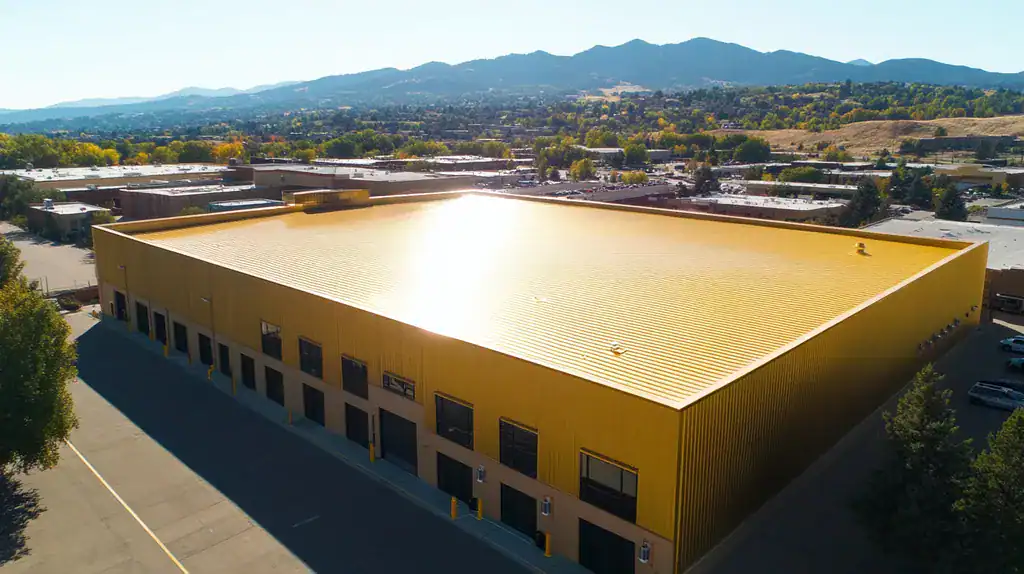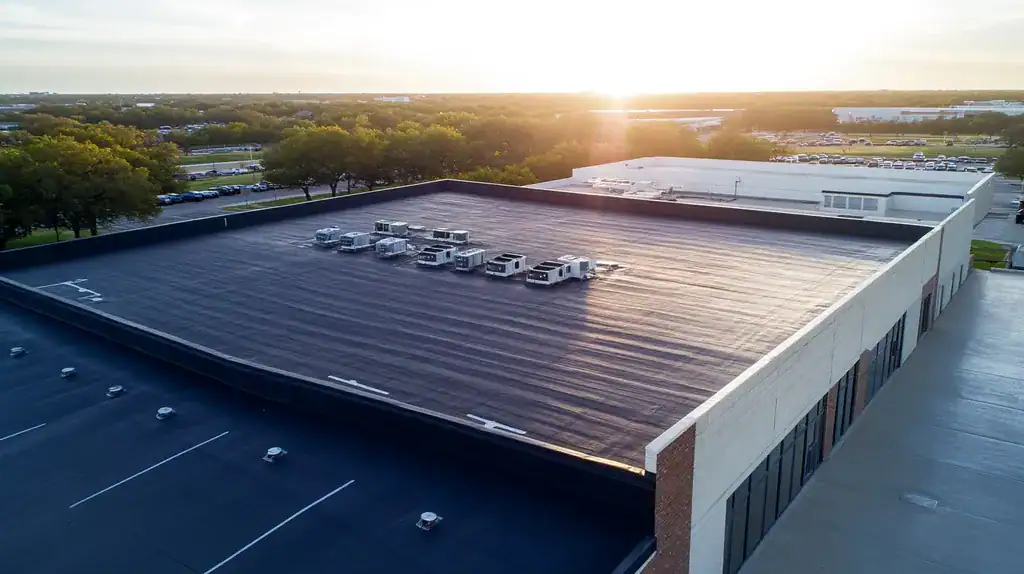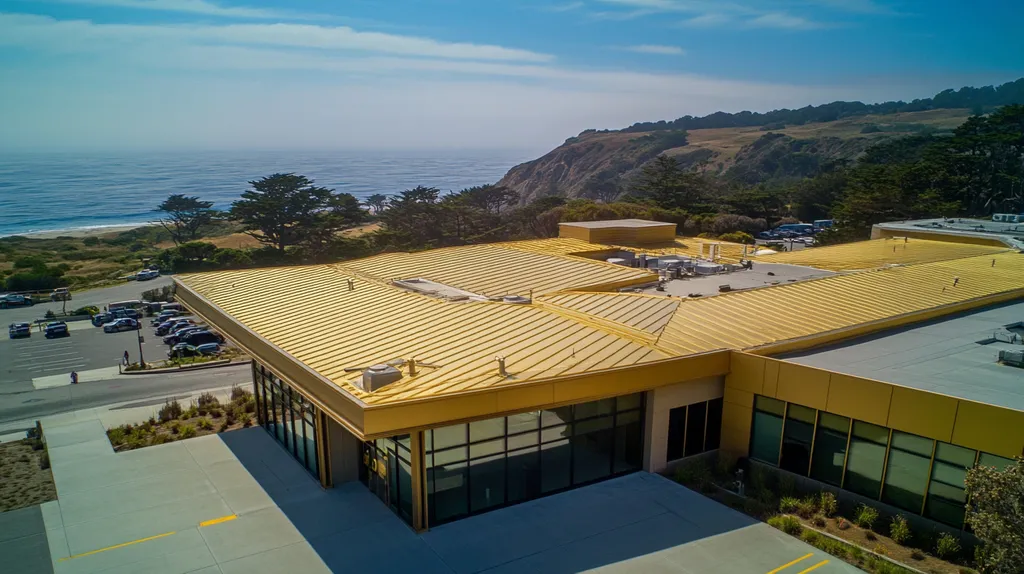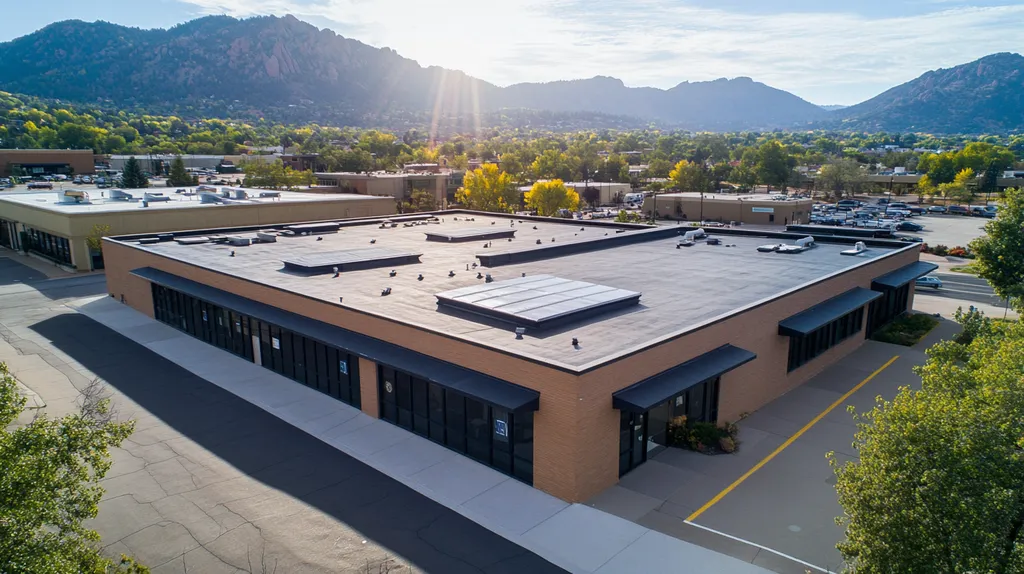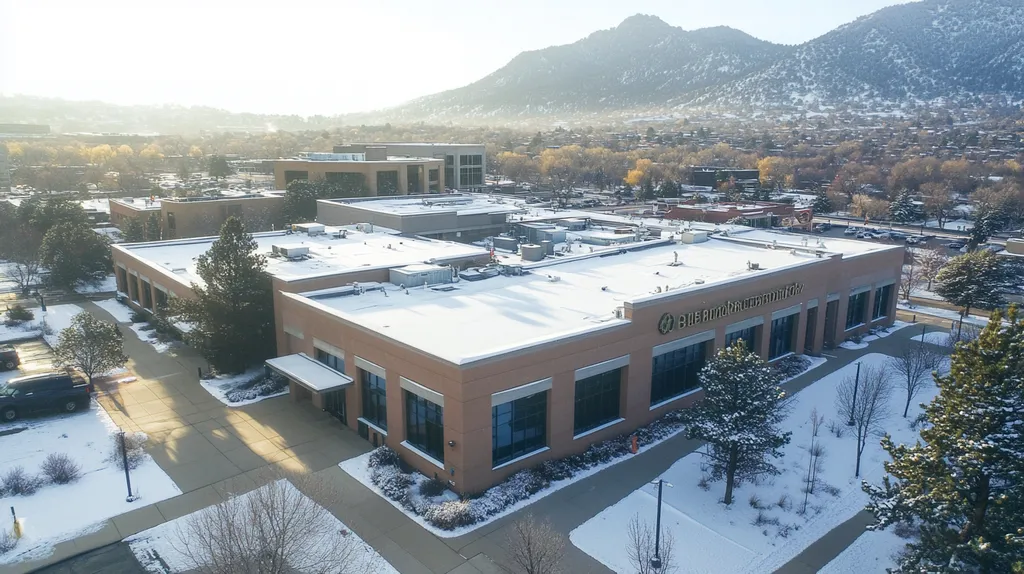Energy costs from inefficient commercial roof lighting systems drain over $6 billion annually from U.S. businesses. Research shows that optimizing these systems can reduce electricity consumption by up to 75% while improving workplace safety and productivity.
Today’s facility managers face mounting pressure to implement energy-efficient lighting solutions that meet increasingly strict building codes and environmental regulations.
This comprehensive guide provides actionable steps for evaluating, upgrading, and maintaining roof lighting systems to maximize both energy savings and operational performance.
SECTION 1: PERFORMANCE FACTORS
In today’s economy, where energy costs are on the rise, optimizing lighting systems on commercial roofs is essential for long-term savings. Research indicates that energy-efficient lighting can reduce electricity bills by as much as 50%. Understanding the performance factors influencing these systems is crucial to maximizing efficiency and durability. This section delves into lighting efficiency standards, energy consumption analysis, and the importance of system reliability.
Lighting Efficiency Standards
Lighting efficiency standards establish important benchmarks for energy use in commercial buildings. Facility managers need to comply with regulations like the Energy Policy Act, which sets required efficiency levels. By following these standards, property owners not only qualify for tax incentives but also significantly reduce energy consumption.
One of the most impactful upgrades is transitioning to LED lighting. LED systems can consume up to 75% less energy than traditional incandescent bulbs. This not only meets regulatory requirements but also translates directly into lower operational costs.
Moreover, energy-efficient lighting can boost workplace productivity. Well-lit environments have been shown to enhance employee performance and satisfaction. Therefore, facility managers should prioritize compliance not just for regulations, but also to foster a better working atmosphere.
Key Action Items
Energy Consumption Analysis
A thorough energy consumption analysis is key to identifying inefficiencies in lighting systems. Regular audits enable facility managers to track consumption trends and pinpoint areas that need improvement. Implementing smart lighting controls can further reduce energy usage by adjusting brightness based on occupancy.
Property owners should also think about employing energy monitoring software to keep tabs on real-time consumption. This technology offers insights into usage patterns, facilitating data-driven decisions and more accurate forecasting of future energy needs.
Inefficient lighting can significantly inflate utility costs. For instance, poorly optimized systems can lead to energy bills that are up to 30% higher than necessary. Consequently, taking a structured approach to energy analysis becomes essential for minimizing waste and enhancing cost-effectiveness.
Key Action Items
System Reliability and Durability
The reliability and durability of lighting systems are essential for maintaining operational efficiency. Facility managers should select equipment that meets efficiency standards while also standing up to the demands of a commercial environment. For example, durable fixtures designed for high-traffic areas can significantly decrease maintenance costs over time.
Smart technology solutions, such as sensors and timers, add to system reliability by automating operations. Features like occupancy sensors ensure lights turn off in unoccupied spaces, extending bulb life and saving energy.
In addition, regular maintenance and inspections are vital to enhance longevity. Routine checks can catch small issues before they evolve into costly repairs. Investing in reliable systems typically results in lower total ownership costs throughout the equipment’s lifespan.
Key Action Items
SECTION 2: FINANCIAL CONSIDERATIONS
The financial implications of lighting systems on commercial roofs present a critical concern for facility managers. With energy costs escalating, the urgency to adopt energy-efficient solutions has never been higher. By evaluating energy expenditures closely, facility managers can pinpoint substantial savings and enhance budget management. This section outlines the key financial aspects, including cost benefits, anticipated energy savings, and return on investment from optimizing roof lighting systems.
Cost Benefit Analysis Overview
A thorough cost benefit analysis can illuminate how investments in roof lighting can yield substantial returns. By weighing initial installation costs against long-term savings, facility managers gain clarity for decision-making. This process involves assessing installation expenses, ongoing maintenance costs, and operational savings potential.
Although switching to LED lighting might carry a higher initial cost compared to traditional options, the benefits are undeniable. With a longer lifespan and lower energy requirements, LED systems generally lead to reduced maintenance and energy bills. Weighing these factors is essential to understanding the financial impact of upgrades.
Additionally, managers should explore local incentives or rebates that could bolster the financial benefits. Various governmental initiatives promote energy efficiency improvements, helping to mitigate initial costs and enhance overall return on investment calculations.
Key Action Items
Energy Cost Savings Estimates
Implementing energy-efficient lighting systems can lead to substantial reductions in operating expenses for commercial properties. Facilities can anticipate saving between 25% and 50% on energy bills by transitioning from outdated lighting to advanced LED technologies. Given the steady rise in utility prices, these savings are particularly crucial.
For instance, a facility of 100,000 square feet that currently spends $30,000 a year on energy could save between $7,500 and $15,000 annually with upgrades. Such reductions not only ease budgeting but also allow for reinvestment in other vital areas of the business.
Furthermore, the cumulative effect of these energy savings over time can be considerable, amplifying the rationale behind investing in energy-efficient lighting. Additionally, efficient systems often lead to reduced cooling demands, further enhancing overall cost-effectiveness.
It is essential for managers to perform regular energy audits to identify opportunities for improvement and accurately estimate potential savings. This proactive approach lays the foundation for more effective energy forecasting.
Key Action Items
Return on Investment (ROI) Calculations
Calculating the return on investment (ROI) for lighting system upgrades is vital for facility managers looking to validate their expenditures. A straightforward ROI calculation involves comparing total savings with initial investment costs over a designated period.
For example, if a lighting upgrade project costs $50,000 with expected annual savings of $12,000, the simple ROI indicates a payback period of roughly 4.2 years, creating a compelling business case for the investment.
Facility managers should also include qualitative benefits in their ROI assessments. Better lighting conditions can enhance employee productivity and satisfaction, indirectly contributing to increased revenues.
Moreover, taking into account available tax incentives and options for accelerated depreciation on energy-efficient upgrades can further improve ROI calculations. These additional benefits strengthen the argument for recommending lighting system improvements.
Key Action Items
SECTION 3: COMPLIANCE REQUIREMENTS
Adhering to compliance requirements for roofing lighting systems is crucial for facility managers. Ignoring building codes, environmental regulations, and safety standards can lead to substantial fines and project setbacks. For example, failing to comply with energy codes may result in penalties that overshadow the cost of installing energy-efficient lighting. Understanding these regulations is essential for sustainable operations and optimal efficiency. This section outlines vital compliance factors affecting lighting systems on commercial roofs.
Building Code Compliance
Building codes are essential for ensuring the safety and functionality of roof lighting systems. These regulations specify design, installation, and maintenance criteria that all facility managers must adhere to. For instance, many jurisdictions require energy-efficient lighting fixtures to achieve certain lumen outputs and energy consumption thresholds. Non-compliance not only jeopardizes safety but may also necessitate expensive retrofitting.
Additionally, codes often require features such as lighting controls that reduce energy waste, including occupancy sensors and dimmers. These components are not optional in many areas; they are mandatory for compliance with energy efficiency standards. Meeting these codes can also enhance the attractiveness of a property to environmentally conscious tenants, thereby improving occupancy rates.
Regular inspections are required to verify compliance, underscoring the importance of continuous monitoring. Facility managers should collaborate with qualified experts to stay informed on local code changes, ensuring that all lighting installations meet legal requirements. Investing in compliance ultimately saves money by avoiding fines and future retrofits.
Key Action Items
Environmental Regulations
Environmental regulations like the Energy Policy Act significantly shape the decisions surrounding lighting systems on commercial roofs. These regulations aim to promote energy efficiency and minimize environmental impact. Facility managers should be aware of how these guidelines affect the types of lighting systems they can utilize. For instance, certain areas mandate that a percentage of lighting systems must incorporate LED technology, which is inherently more energy-efficient than older bulbs.
Furthermore, regulations regarding waste disposal critically impact how outdated lighting systems are managed. Improper disposal of fluorescent bulbs can lead to substantial fines due to hazardous waste laws. Companies failing to comply not only face financial penalties but may also suffer reputational damage that can harm business relationships.
Proactive measures, such as frequent audits and timely updates to lighting systems, are vital for maintaining compliance with environmental regulations. Facilities that adhere to these standards often qualify for grants or incentives promoting sustainable practices, thereby increasing their overall value.
Key Action Items
Safety Standards and Certifications
Compliance with safety standards is essential for ensuring the integrity and safety of roofing lighting systems. Organizations such as the Occupational Safety and Health Administration (OSHA) establish guidelines that protect workers during installation and maintenance. Facility managers must guarantee that all lighting systems conform to OSHA regulations to mitigate workplace hazards.
Moreover, products with certifications from credible organizations like Underwriters Laboratories (UL) signal compliance with high safety and performance standards. Selecting certified equipment helps reduce risks related to electrical faults and fire hazards, preventing potential damages and injuries.
Regular safety training for maintenance staff is also crucial. Understanding safety protocols ensures compliance while cultivating a safety-first culture within the organization. Implementing effective training can shield the company from liabilities resulting from accidents or mishandling of lighting systems.
Key Action Items
SECTION 4: RISK MANAGEMENT
Effective risk management is imperative for facility managers focused on optimizing roof lighting systems. Failure to address potential issues can lead to unexpected downtimes and significant safety hazards. A staggering 30% of commercial buildings experience unplanned outages due to poor lighting management. Identifying risks and applying strong mitigation strategies ensures the safety of the facility and its occupants while maximizing energy efficiency.
Hazard Identification and Mitigation
Facility managers need to proactively identify hazards linked to roof lighting systems. Hazards such as electrical failures, water leakage, and structural weaknesses present serious risks. Conducting regular inspections and assessments helps uncover these vulnerabilities before they escalate into costly problems.
For instance, outdated wiring may significantly increase the risk of fires or system failures. Utilizing automated lighting audits can detect these issues early on. Furthermore, integrating weather-resistant fixtures can improve safety and extend the system’s lifespan.
Training staff on emergency protocols is vital to mitigate risks connected to sudden lighting outages. This proactive approach fosters a culture of safety, ultimately reducing liabilities for property owners.
Key Action Items
System Failure and Emergency Response
Lighting system failures can disrupt operations and compromise safety. Establishing an efficient emergency response plan is crucial to minimizing impacts during such incidents. Facility managers should create detailed protocols outlining immediate actions to take when failures occur.
For example, installing a dedicated emergency lighting system keeps essential areas illuminated in case of power outages. Regular testing of these systems can reveal vulnerabilities before they escalate.
Having clear communication channels helps ensure that employees know who to contact and what steps to follow during outages. This awareness reduces confusion and expedites recovery efforts.
Key Action Items
Maintenance and Repair Strategies
Consistent maintenance is crucial for ensuring the reliability of roof lighting systems. Establishing a comprehensive maintenance strategy that incorporates routine inspections and repairs is necessary. Failing to address this can lead to higher operational costs and increased safety hazards.
For instance, replacing burnt-out bulbs during scheduled inspections can prevent larger issues such as electrical failures. Choosing high-quality, energy-efficient fixtures minimizes repair frequency and optimizes system performance.
Implementing a systematic record-keeping approach for maintenance activities enables tracking repairs and identifying recurring issues. This informed strategy helps anticipate potential problems before they escalate.
Key Action Items
SECTION 5: OPERATIONAL PROCEDURES
Establishing a robust operational framework for lighting systems on commercial roofs is vital for maximizing efficiency and reducing costs. Research shows that effective lighting strategies can lower energy expenditures by as much as 40%. This section outlines the fundamental procedures for installation, ongoing maintenance, and troubleshooting, ensuring systems operate at peak performance.
Installation and Commissioning Checklist
Effective installation is paramount for optimizing energy efficiency in roof lighting systems. Start with a comprehensive site assessment to analyze the roof’s layout and identify potential shading issues. Utilizing high-efficiency fixtures, such as LED lights, is crucial to impact overall energy performance.
Ensure fixtures are positioned according to their light distribution patterns. Installing smart lighting controls can further enhance efficiency by adjusting brightness based on available natural light, ensuring maximum illumination while conserving energy.
Once installation is complete, conduct a thorough system commissioning to confirm all components are functioning correctly. This should involve testing lighting levels against established performance standards and documenting the process for future reference. Compliance with local electrical codes and safety standards is essential to mitigate risks.
Key Action Items
Maintenance and Inspection Schedules
Consistent maintenance is crucial for keeping lighting systems efficient and operational. Establish a routine inspection schedule that includes evaluating bulb performance, checking fixture cleanliness, and assessing control functions. Inspections should occur at least quarterly, though more frequent checks may be necessary in high-traffic areas.
During inspections, ensure light fixtures are cleaned regularly to enhance output, and examine electrical connections to prevent malfunctions. Promptly replacing faulty bulbs helps sustain consistent lighting levels and operational efficiency.
Keep meticulous records of all maintenance activities to track performance trends, allowing for early detection of potential issues. An effective maintenance strategy not only reduces long-term costs but also advances sustainability goals by maintaining operational efficiency.
Key Action Items
Troubleshooting Common Issues
Quickly identifying and addressing issues can prevent energy waste and extend the lifespan of lighting systems. Start troubleshooting by ensuring the power supply is intact and checking that all switches and sensors are operational if lights are unresponsive.
For systems exhibiting flickering or inconsistent illumination, inspect wiring and connections, as these issues often arise from aging components that may require replacement. Unexpected increases in energy bills should prompt a review of usage patterns and operational hours.
If problems persist, enlisting the help of a professional can mitigate the risk of exacerbating issues over time. Proactively addressing challenges fosters a more efficient and sustainable lighting system.
Key Action Items
SECTION 5: OPERATIONAL PROCEDURES
Establishing an effective lighting system on a commercial roof is crucial for maximizing efficiency and minimizing energy costs. Research shows that well-designed lighting strategies can cut energy expenditures by up to 40%. This section provides essential operational procedures for installation, regular maintenance, and troubleshooting to ensure your systems run at peak performance.
Installation and Commissioning Checklist
Proper installation is key to achieving maximum energy efficiency in roof lighting systems. Start with a thorough site assessment to understand the roof layout and identify potential shading issues. Utilizing energy-efficient fixtures, like LED lights, can greatly enhance overall energy performance.
Be sure to position all fixtures according to their light distribution patterns. Consider integrating smart lighting controls that adjust brightness based on available natural light, ensuring effective illumination while conserving power.
Once installation is complete, conduct commissioning tests to verify that all components operate correctly. This involves checking lighting levels against performance standards. Document the process for future reference and ensure compliance with local electrical codes and safety standards.
Key Action Items
Maintenance and Inspection Schedules
Consistent maintenance is essential to keep lighting systems efficient and operational. Create a routine inspection schedule that includes evaluating bulb performance, fixture cleanliness, and control functions. Inspections should occur at least quarterly, or more frequently in high-traffic areas.
During these inspections, clean light fixtures to maximize output and check all electrical connections to prevent malfunctions. Promptly replace any defective bulbs to sustain consistent lighting levels.
Documenting all maintenance activities allows for tracking performance trends and identifying potential issues early. This not only enhances safety but also supports better budgeting for future repairs or upgrades.
Key Action Items
Troubleshooting Common Issues
Quick identification and resolution of issues can prevent energy loss and enhance the lifespan of lighting systems. Start by checking the basics: if lights are not functioning, verify that the power supply is intact and ensure all switches or sensors are operational.
For flickering or inconsistent illumination, inspect wiring and connections, as these issues often arise from aging components that may need replacement. Unexplained increases in energy bills should prompt a review of usage patterns and operational hours.
If problems persist, consulting a professional can help mitigate more significant issues down the line. Proactive troubleshooting fosters a more efficient and sustainable lighting system.
Key Action Items
The Bottom Line
With energy costs rising 8% annually, optimizing commercial roof lighting systems is no longer optional – it’s a business imperative that directly impacts the bottom line.
Studies show that facilities implementing the strategies outlined in this guide reduce lighting-related energy consumption by 50-75% while enhancing workplace safety and productivity.
The key to success lies in taking a systematic approach: conducting thorough energy audits, upgrading to LED technology, implementing smart controls, and maintaining rigorous inspection schedules.
By following these evidence-based recommendations, facility managers can dramatically cut operational costs while ensuring their lighting systems meet increasingly strict efficiency standards and environmental regulations.
The time to act is now – every month of delay means thousands in preventable energy waste.
FREQUENTLY ASKED QUESTIONS
Q. What are the performance factors affecting commercial roof lighting?
A. Performance factors include lighting efficiency standards, energy consumption analysis, and system reliability. Regular audits can identify inefficiencies and help maximize energy savings for commercial roofs.
Q. How can I determine potential savings on my industrial roof lighting?
A. Conducting a cost benefit analysis will reveal potential savings. Transitioning to energy-efficient solutions can yield substantial reductions in operational expenses for industrial roofs.
Q. What compliance requirements must I meet for a commercial roof lighting system?
A. You must adhere to local building codes, environmental regulations, and safety standards to ensure your lighting systems meet legal requirements and avoid fines.
Q. How can I manage risks associated with roof lighting systems?
A. Implement regular inspections and adopt an emergency response plan to identify hazards. Being proactive helps mitigate risks linked to roof lighting systems.
Q. What operational procedures are essential for lighting systems?
A. Establish a routine for installation, regular maintenance, and troubleshooting. This ensures maximum efficiency and reduces energy costs for your commercial roof systems.
Q. How often should I inspect my commercial roof lighting systems?
A. Inspections should occur at least quarterly, with more frequent checks in high-traffic areas. Regular inspections help identify issues before they escalate and ensure reliability.
Q. What are the benefits of using smart lighting controls on industrial roofs?
A. Smart lighting controls enhance energy efficiency by adjusting brightness based on occupancy and natural light. This leads to significant energy savings and improves operational efficiency.


